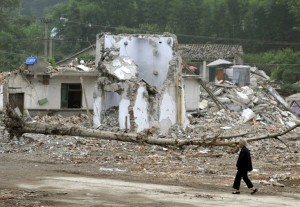Flattened by quake, Chinese city rises from the rubble

An elderly woman walks past collapsed buildings in Xiang’e village of Dujiangyan city, in China’s southwestern province of Sichuan on June 11, 2008. AFP FILE PHOTO
DUJIANGYAN CITY, China—More than six years after a magnitude-8 earthquake destroyed this city, reducing homes, schools and hospitals to rubble and killing more than 3,000 people in the city alone, Dujiangyan today bears no trace of the tragedy.
Sun Ling Xia, director of Dujiangyan City’s Reconstruction Management Office, said their success at rebuilding their city was anchored on scientific planning that respects the decision of the locals and funding which came mostly from the central government and the city government of Shanghai.
Sun likened the role of the Chinese central government to that of a parent. “Just like a parent, the central government came to our aid and provided us with financial assistance after the quake,” he said.
Like a parent
The central government financed the rebuilding of hospitals and schools and subsidized the rebuilding of resident homes. Sun emphasized that a portion of the rebuilding cost was shouldered by the homeowners themselves.
Article continues after this advertisementThe local government, on the other hand, executed the reconstruction after undertaking research and determining how much funds were needed to finance the city’s rehabilitation.
Article continues after this advertisement“During the earthquake, Dujiangyan people suffered a lot,” said Sun, addressing members of the Philippine media who were on a cultural and economic familiarization tour of southwest China.
“As director of the Reconstruction Management Office, I have the responsibility to help the people rebuild their homes,” she said.
“Now you cannot find any trace of the earthquake in Dujiangyan City. That means the city has come out from the shadow of the earthquake,” Sun said.
Sun said she was willing to share Dujiangyan’s rehabilitation experience with other countries like the Philippines. Chinese foreign ministry officials have said that Tacloban Mayor Alfred Romualdez and Leyte Rep. Ferdinand Martin Romualdez last year initiated talks for this purpose with Chengdu City, the capital of China’s Sichuan province under whose jurisdiction Dujiangyan belongs.
When an agreement is finalized, Tacloban will become Chengdu’s first sister city in the Philippines, as well as its first sister city for disaster preparedness and rehabilitation.
Currently, Chengdu has more than 40 sister cities all over the world, including Montpelier in France, Phoenix in the US, Winnipeg in Canada, Medan in Indonesia and Sydney in Australia.
The Chinese foreign ministry explained that Chengdu learns from each of its sister cities. Chengdu exchanges technologies with its sister cities in the US, while it exchanges students with its Australian sister cities. For sister cities in Asia, the partnership is usually for tourism and cultural exchange.
The Chinese Foreign Ministry noted that Chengdu does not yet have a sister city with whom it exchanges stories of rehabilitation. “We hope to be able to share our reconstruction stories with Tacloban,” they said. Tacloban was destroyed by Super Typhoon “Yolanda” in November 2013.
Quake damage
Across China, the 2008 earthquake caused some RMB845 billion (renminbi yuan, or about $138 billion) in direct economic losses. Direct economic losses in Dujiangyan alone amounted to RMB53 billion ($8.7 billion).
“The earthquake dealt very serious damage. After it hit, the whole of Dujiangyan was nearly destroyed,” she said. “For the first two days, the people had no homes, no access to clean water, no power—but only for those days. Three days later, we were already able to restore access to clean water, power, food and even temporary shelter.”
Immediately after the quake, Dujiangyan’s focus was on “quick relief,” which included helping the injured and helping build temporary shelters. The relief phase lasted for three months.
“The government played a major role in the rescue work—we sent the military, and poured in all civil society support into disaster relief. That is why we were able to finish relief in three months,” she said.
Three months later, the focus shifted to rebuilding the houses.
Fast reconstruction
Six years after the earthquake, some of Dujiangyan’s reconstruction efforts are still going on. However, because they managed to finish transferring all affected families to their new homes within three years, today they are focusing on not only rebuilding industries, but also at expanding them, Sun explained.
“The reconstruction speed was so fast, it astonished the international community, and even us,” she said.
“As local government, we did the reconstruction by ourselves. We did the research, then we determined how much funds we needed through planning. Then we did the reconstruction work according to that plan,” said Sun.
According to Sun, while experts were invited to help with the postquake reconstruction, the participation of Dujiangyan residents in the planning was also crucial.
“Our planning also involved the people themselves, because they would be the ones living in those reconstructed homes,” she said. She said the local government chose 1,000 residents to help in the planning.
“The government cannot take care of everyone, so the government finds ways to encourage the people to help themselves,” she said.
Huang Yangxia, 40, lives in Wugui village (population: 500 persons), one of the areas destroyed by the quake but now has been fully rebuilt.
Huang now lives in a two-story house (she says her old house was even bigger) with her husband and her parents. The family home was rebuilt on its old site. While it was being rebuilt, Huang’s family had to build and live in a temporary shelter somewhere else.
“The city now looks like the earthquake never happened. The people themselves have also come out of its shadow,” said Sun.